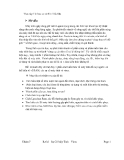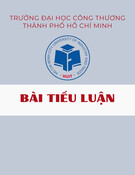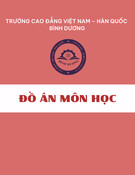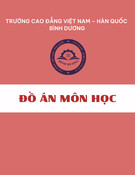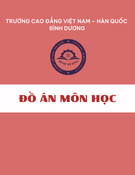
HUE UNIVERSITY
UNIVERSITY OF SCIENCES
NGUYEN VAN TRUNG
METHODS OF
PROCESSING INCONSISTENT KNOWLEDGE
IN ONTOLOGIES
MAJOR: COMPUTER SCIENCE
CODE: 62.48.01.01
SUMMARY OF DOCTORAL THESIS
OF COMPUTER SCIENCE
HUE - 2018

The thesis has been completed at:
Hue University of Sciences - Hue University
Supervisor:
Assoc. Prof. Dr Hoang Huu Hanh
Reviewer 1: ......................................................................................
......................................................................................
Reviewer 2: ......................................................................................
......................................................................................
Reviewer 3: ......................................................................................
.......................................................................................
The thesis will be presented at the Committee of Hue University,
to be held by Hue University at ...... ..... , 2018
The thesis can be found at the following libraries:
•National Library of Vietnam
•Library Information Center University of Science, Hue University

PREFACE
1. The necessity of the topic
In 2001, Tim Berners Lee and coworkers have propose a new “a new form of Web
content that is meanningful to computers”. The new generation of web that use this
form of content called as Semantic Web, allows computers can “understand” stored
knowledge, by that way can share and re-use knowledge bases in information systems of
several domains. Compare with current generation web – as a repository of documents
that links together, Semantic Web is a platform that stores information in a form of
explicit definition, allow computers and human can work together.
Semantic Web is a research domain that quickly expands and is interested in by re-
search community in the last decade. Semantic Web technologies are applied in several
aspects. The most important component in Semantic Web applications is ontology.
In an ontology people define entities (concepts, properties, instances) and rela-
tionships between these entities by semantics of a specific logic. Ontology language
that using most popular today and standarized by W3C is OWL. The newest ver-
sion of this language is OWL 2 (introduced in 2009) based on the Description Logics
SROIQ(D).
The important issue of Semantic Web is handling inconsistent knowledge in onto-
logies. This issue come from properties of building and using ontologies in Semantic
Web applications: Extensibility and shareability, distributed and multi-users potenti-
ally cause occurring inconsistent knowledge.
Actually, if an ontology is inconsistent, queries against it are meaningless. Reason
of this is any axiom is logic consequence of an inconsistent ontology. In another way,
inconsistency causes ontology useless in Semantic Web applications. Due to that rea-
son, processing inconsistent knowledge in ontologies is the important problem and has
practical sense and attracts computer science community.
2. Research motivation and researching approaches
Approaches of processing inconsistent knowledge in ontologies are classified in two
categories: (1) approaches that tolerate existence of inconsistent knowledge in ontology,
and (2) approaches that try to remove inconsistency from ontologies:
(1) Approaches that tolerate existence of inconsistent knowledge in ontology. Some
approaches in this category define Description Logics with para-consistent semantics
and building ontology in these logics. Using para-consistent logics to build ontology,
although allows to model comprehension knowledge but have difficulties in reality
deployment because of popularity of ontology language that standarzed and recom-
mended by W3C.
Actually, in many circumstances, Semantic Web application need to query infor-
mation which are integrated from ontologies coming different sources (and may be
inconsistent) without modification permission. A solution for this issue is framework
of reasoning with inconsistent ontology using linear extension strategy, proposed by
Zhisheng Huang, Frank van Harmelen and coworkers. This framework evaluates mea-
ningful results for queries against inconsistent ontologies by select a subset of axioms
from input ontology: axioms in this set relevant to query in a given criteria. The most
important component of reasoning framework is selection function that use to select
1

the axioms set. Two typical selection functions of the authors are: the syntactic-based
selection function and Normal Google Distance based selection function. Both of the
two selection functions have advantages due to dependence of syntax of axioms. Over-
coming these advantages is a research motivation of the thesis: We propose a way to
select axioms set by semantic relevance of axioms to input query. The relevance is
evaluated based on semantic distance between concept expression when place them in
concepts hierarchy of the so-called referenced ontology.
(2) Approaches that try to remove inconsistency from ontologies. Creation of on-
tology is based on two strategy: the first strategy is finding and suggesting to modify
or remove axioms from ontologies; and the second strategy is apply consensus theory
to process of determining axioms set, which best represents (in the given criteria) for
input ontologies. The first strategy is often used for maintaining consistency of an
ontology. In the meanwhile the second strategy is used to resolve conflicts in process
of integrating ontologies coming from severals distributed, independent sources.
Methods of resolving conflict of knowledge that based on consensus theory have
been proposed by professor Ngoc Thanh Nguyen and co-workers in 2002 extended in
following years. Authors classify conflicts in ontologies integration to levels of concepts,
relationships, instances and propose methods to resolving these levels of conflict.
By structure of a concept in ontology integration process, people consider two
aspects: the list of attributes to describe the concept, and their domain. However, the
current researches of handling conflict at concept level only resolve conflict of the list
of attributes while domain of each attribute in the integration concept is determined
as sum of the participant domains. This means that conflict of attributes’ domain is
omitted. Thesis will apply general consensus-based models for integrating knowledge
and propose a new approach to resolve conflict at the concept level in both of two
aspects: list of attributes and their domains.
Another level of conflict may also occurs in process of ontology integration is level
of axiom, such that axioms set of participant ontologies are different or even contradict
each other. This circumstance also occurs in building process of ontology collaborati-
vely and distributively by multiple users (volunteer users in wiki environment or the
like, or hired experts) Conflict in level of axiom in ontology integration currently has
no good and effective resolution (like other levels of conflict). By representing an axiom
by a literal, each participant ontology can be modeled as conjunction of literals. In
this way, the problem of resolving conflict of axioms set can be treated as the problem
of resolving conflict at syntactic level of conjunctions. We propose a distance function
between two conjunctions, analyze postulates for consensus’s conjunction and formu-
late a strategy to determine consensus conjunction. The result of this process can be
applied to problem of process conflict at the axiom level.
3. Research objectives and scope of research
Research subjects of the thesis are ontology, inconsistent knowledge in ontologies
and methods of processing inconsistent knowledge in ontologies. By analyzing research
motivations, we address objectives of research for processing inconsistent in ontologies
by the two tasks: querying and integrating. In particularly, we restrict the objectives
of research by three problems following:
•The first problem: Determine meaningful result for querying inconsistent onto-
2

logy. In this problem, we research and propose a method to use the referenced
ontology for evaluating semantic distance between two concepts, between two
concept expression, between two axioms. This semantic distance will be used to
formulating a selection function that applying in framework of reasoning with
inconsistent ontology.
•The second problem: Resolving conflict of concept level in ontology integration.
We apply general consensus-based models for integrating knowledge to determine
consensus for the concept’s structure. The conflict of concept’s structure will be
resolved in both attributes list and their domains.
•The third problem: Resolving conflict of axiom level in ontology integration. By
representing conflict of axiom level in ontology integration as conflict of syntactic,
we evaluate difference of axiom sets and formulate a method to determine the
consensus axiom sets that satisfies postulates which based on this difference.
Chapter 1
OVERVIEW ON PROCESSING
INCONSISTENCY IN ONTOLOGIES
1.1. Ontology and inconsistent knowledge
Definition 1.1 (Ontology).An ontology is a quadruple hC,I,R,Zi, where: Cis a set
of concepts (classes); Iis a set of instances of concepts; R;Ris a set of relationship;
Zis a set of axioms which can be interpreted as integrity constraints or relationships
between entities (concepts, instances, relationships).
We also call Rin the Definition 1.1 as the set of properties. One classify two kinds
of properties: object property which links instances, and datatype property which links
instance to a data value.
An ontology is called as inconsistent if it has no model. The reason of this is the
set of its axioms contains contradiction. Querying against an inconsistent ontology
is meaningless because every axiom is logic consequence of the set of axioms which
contains contradiction.
In this theses, we deal with the inconsistency in ontology by addressing the fol-
lowing two problems: querying inconsistent ontologies and, resolving inconsistency in
ontology integration. Basic theories for these problem – general framework for reaso-
ning with inconsistent ontologies, and consensus theory — will be introduced in this
overview chapter.
1.2. Framework for reasoning with inconsistent ontologies using linear extension
strategy
1.2.1. Basic definition
Framewotk for reasoning inconsistent ontology was proposed by Zhisheng Huang,
Frank van Harmelen etal in 2005. In this framework, ontology is viewed as a set of
axioms and not restricted to any ontology language. Call Las an ontology language,
we denote 2Las the set of all set of axioms in L. Ontology Σcan be view as a set of
3



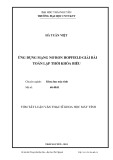
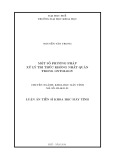

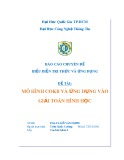
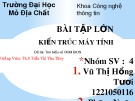
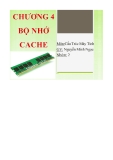
![Quy trình phát triển của máy tính và nguyên tắc sáng tạo: Tiểu luận [chuẩn SEO]](https://cdn.tailieu.vn/images/document/thumbnail/2013/20131107/online_12/135x160/4571383790302.jpg)
